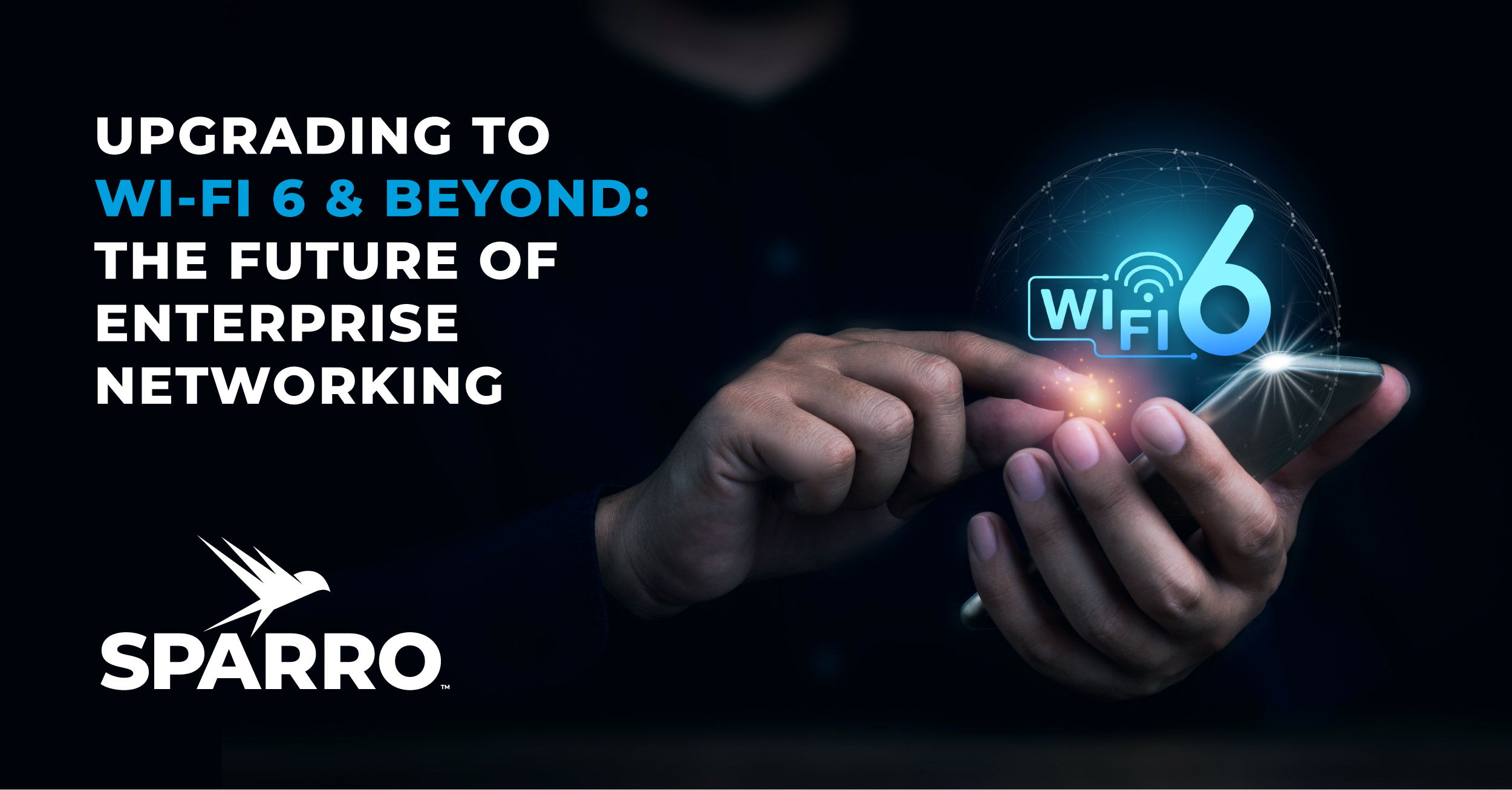Table of Contents
- Why Do These Upgrades Matter?
- How Wi-Fi 6, 6E, and 7 Can Help
- How Can Enterprises Prepare for Upgrading to Wi-Fi 6 and Beyond?
- The Future of Wireless Networking
As enterprises strive to keep up with the increasing demands of digital transformation, wireless network infrastructure has become more critical than ever. Wi-Fi 6 (802.11ax), Wi-Fi 6E, and the recently released Wi-Fi 7 (802.11be) bring many enhancements to previous generations of Wi-Fi. These advancements promise to significantly enhance performance, improve security, and handle more devices in high-density environments.
Why Do These Upgrades Matter?
Today’s Wi-Fi networks are overwhelmed with data, particularly in high-traffic environments such as office buildings and dense manufacturing environments. According to the Wi-Fi Alliance, Wi-Fi traffic has roughly quadrupled in the past four years. Previous Wi-Fi standards prioritized throughput, but the tradeoff was more congested networks.
Wi-Fi 6, Wi-Fi 6E, and, even more so, Wi-Fi 7 will alleviate most of today’s connectivity woes with significantly more bandwidth, faster speeds, and “smart Wi-Fi” capabilities. Such advances will allow data to move more intelligently, enabling new applications.
These new standards are designed to support more devices with improved performance, reduced interference, and enhanced security. This will provide a better overall experience, especially in properties with many users and devices online simultaneously. They will also better support IoT (Internet of Things), cloud computing, and smart home solutions that require increased reliability and lower latency.
How Wi-Fi 6, 6E, and 7 Can Help
To understand how Wi-Fi works, we often use the metaphor of a highway. A wider highway with more lanes will result in less congestion, greater speeds, and a more enjoyable experience. Wi-Fi 6 added more lanes than previous versions for improved connection speeds. It also began using techniques such as OFDMA (Orthogonal Frequency Division Multiple Access) to enable devices to use those lanes more efficiently.
Wi-Fi 6E enables devices to use the new 6 GHz spectrum released by the FCC, thus increasing the number of lanes even further. However, Wi-Fi 7 goes even further, adding the ability to use more than one lane at a time (or even more than one highway at a time) and boosting the capacity and speed of the car on the road.
Wi-Fi 6, Wi-Fi 6E, and Wi-Fi 7 are thus not merely an incremental improvement to existing connectivity infrastructure. Wi-Fi 7, in particular, creates an entirely different framework for technologies that enable a vastly different experience than what we are used to today.
Greater Capacity
Most Wi-Fi networks today use two frequency bands: 2.4 GHz and 5 GHz. These differ in several ways, but basically, in the 2.4 GHz band, data travels farther at lower speeds, while the 5 GHz band provides faster speeds in a shorter range. Dual-band-enabled Wi-Fi devices allow users to connect to the band best suited for a particular application or device. This worked well until these bands became overwhelmed with traffic. This is where 6 GHz Wi-Fi enters the picture with Wi-Fi 6E and Wi-Fi 7.
With up to 59 channels of 20 MHz each, the 6 GHz band has more than 20 times the capacity of the 2.4 GHz band (3 x 20 MHz channels in the US) and 6.5 times the capacity of the 5 GHz band (9 x 20 MHz channels in the US). This allows the network to accommodate more data at faster speeds with less interruption and higher throughput. This performance enables the expansion of applications such as IoT solutions that require greater bandwidth.
Faster Transmission
Wi-Fi 7 goes beyond simply adding channels to changing how traffic uses those channels. All 802.11 Wi-Fi standards rely on an approach known as Quadrature Amplitude Modulation (QAM) to arrange data for transmission. Wi-Fi 7 uses a more advanced version called 4096 QAM to incorporate more data into each transmission, enabling far greater throughput and faster transmission speeds – in fact, a 20% data rate increase over Wi-Fi 6.
Higher Throughput
Channel bonding is a customary practice that enables combining adjacent channels for increased throughput. Essentially, devices split traffic at the packet level across multiple channels and then recombine it after transmission. Successive Wi-Fi standards have allowed for the use of increasingly wider bonded channels.
Wi-Fi 7 supports up to 320 MHz of combined channel width, or twice the width available with Wi-Fi 6. This will significantly improve the usability of Wi-Fi networks, especially for data-heavy applications such as high-definition streaming and immersive augmented reality.
Faster Speeds, Lower Latency, and Higher Reliability
Wi-Fi 6E improves connectivity by adding the 6 GHz band. However, Wi-Fi 6E routers still have limitations, as users can only connect to one band at a time (either 2.4 GHz, 5 GHz, or 6 GHz). Thus, a device may not be using the fastest available band, while some bandwidth may go unused.
Wi-Fi 7 further improves connectivity by enabling multi-link operation (MLO), wherein users can connect to multiple bands simultaneously. This potentially triples throughput, significantly improving network speed, latency, and reliability. By enabling seamless handoffs between bands based on performance, MLO will finally enable the multi-user capabilities first promised by Wi-Fi 6.
MLO also delivers redundancy and lower latency by enabling the use of priority channels and the ability to schedule traffic. This makes it more feasible to implement solutions requiring communication among many devices, such as IoT technology.
Better Overall Performance
Historically, devices have selected a transmission band based on the needs of specific applications. Wi-Fi 7, however, allows access points (APs) to communicate and coordinate with one another. This enables them to determine which AP is best suited to support a particular application based on the current connectivity in each band. The APs support one another by assigning bandwidth to connected devices and associated applications for improved performance.
An Improved User Experience
Wi-Fi 7 offers several improvements for a better user experience:
- By doubling the capacity and tripling the speed of Wi-Fi 6, Wi-Fi 7 can support more devices in use concurrently. This will end the frustration caused by performance lags when others are using the network.
- Wi-Fi 7 also offers a greater effective range with a stronger signal to minimize dead zones.
- With features such as TWT (Target Wake Time), both Wi-Fi 6 and Wi-Fi 7 lower the overall power usage of devices by better managing sleep and wake times. This allows for more efficient operation and lower battery consumption.
- For greater security, Wi-Fi 7 improves support for WPA3 security (when used with the 6 GHz band) with robust authentication and encryption.
Faster Connections with Less Interference
Finally, to support improved communication using the next generation of Wi-Fi devices, APs can now overlap their coverage instead of interfering with one another’s data stream. For high-quantity or high-quality data transfers, multiple APs can broadcast the same information to one device without interference, improving transfer speed. This revolutionary practice will enable faster connections with little to no interference to better support real-time applications.

How Can Enterprises Prepare for Upgrading to Wi-Fi 6 and Beyond?
Now that more user devices support these newer standards, you’ll want to consider upgrading your enterprise network to include support for this technology. Some aspects to address include:
1. Upgrade to Future-Proof Hardware
While Wi-Fi 6E devices can use older networks, as devices are generally backward compatible, they won’t be able to use updated networking features unless they’re using a 6 GHz-enabled network. Wi-Fi 6E-enabled gateways, routers, and access points (APs) have been available for some time, and as of early 2024, certified Wi-Fi 7 equipment has started to reach the market. As more user devices and network equipment become available, there is a stronger case for upgrading your network to support 6 GHz Wi-Fi.
2. Upgrade Your Digital Infrastructure
Enterprises can also prepare by improving other facets of their existing digital infrastructure:
- We recommend the installation of fiber optic cabling for backbone networks, as it has virtually infinite capacity and can operate across longer cable distances.
- Cat6a twisted pair structured wiring will also work, although it is less future-proof than fiber.
- APs should be placed as close as possible to where users will access them, with sufficient density to accommodate the many devices that modern users operate. This will compensate for the shorter range of the newer standards.
3. Plan for IoT, Cloud Computing, and BYOD
IoT technology is becoming more widespread, thus putting a great demand on older networks with less capacity. With more devices connecting to your network, it’s essential to allocate enough bandwidth for reliable operation. It’s also crucial to ensure your network can manage a high volume of concurrent connections.
Cloud computing is another technology to consider when planning infrastructure upgrades. As more data travels to and from the cloud, it’s crucial to incorporate enough capacity to avoid bottlenecks at every point along the way.
For enterprises with BYOD (Bring Your Own Device) policies, having a robust infrastructure ensures that bandwidth is allocated effectively to avoid congestion. This will yield a better user experience and support applications that require low latency.
4. Train Your IT Team
As with all new technology introductions, your IT team must stay ahead of the learning curve. Ensure they’re trained on new security protocols such as WPA3 and the expanded 6GHz spectrum in Wi-Fi 6E and Wi-Fi 7. This preparation will enable smoother deployment and better troubleshooting down the line.
The Future of Wireless Networking
Wi-Fi 6, Wi-Fi 6E, and Wi-Fi 7 are not just incremental updates – they represent the future of wireless networking. Enterprises that adopt these technologies early will reap benefits in terms of speed, reliability, and capacity, positioning themselves to handle the growing demands of modern business operations. By preparing now and investing in future-proof infrastructure, enterprises can ensure they are ready for the wireless future.
If you’re looking to future-proof your connectivity, Sparro can help. We orchestrate the digital transformation of enterprise customers through network infrastructure improvements, private 5G networks, adaptive networking, edge computing, IT agility, and connected security. We design your custom solution for easy installation, maintenance, monitoring, and management to simplify the path to deployment and use. To get your enterprise ready for the future, call us today!

